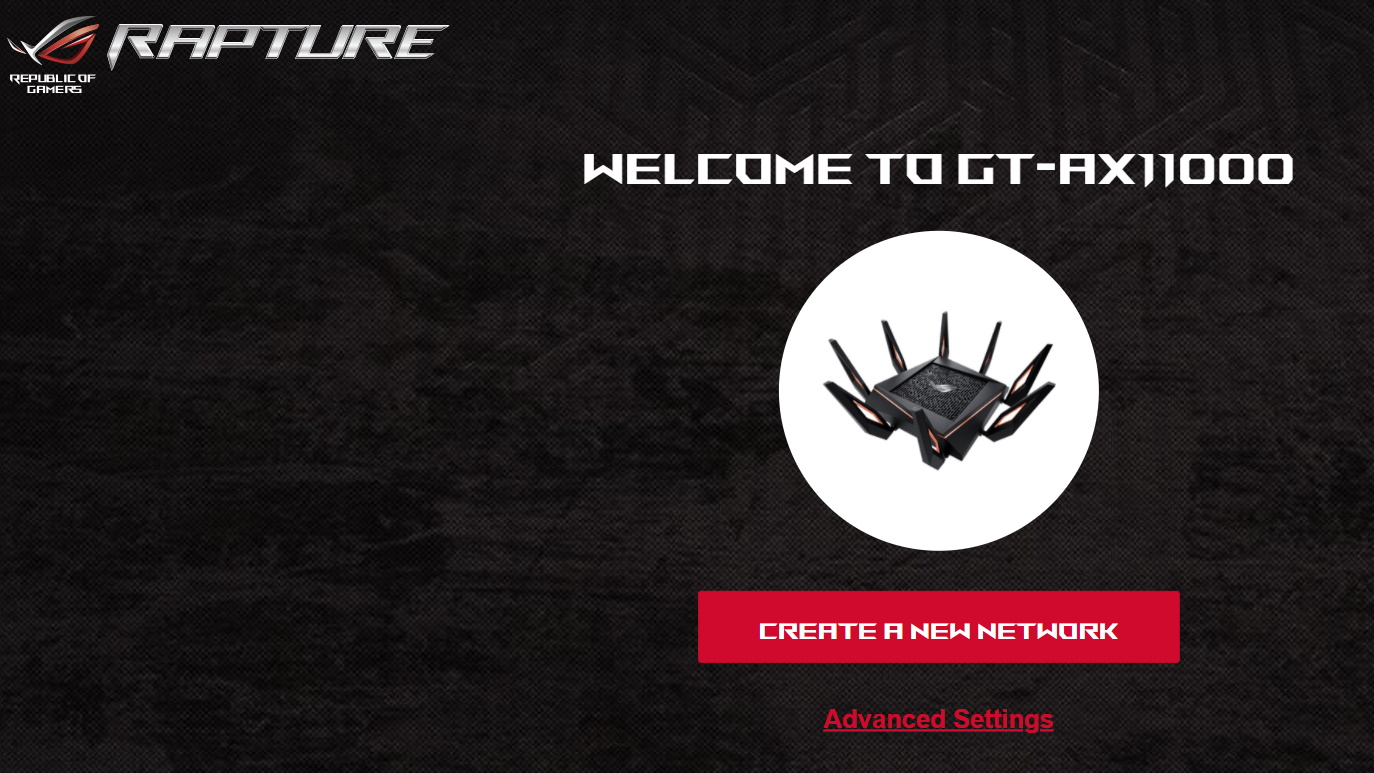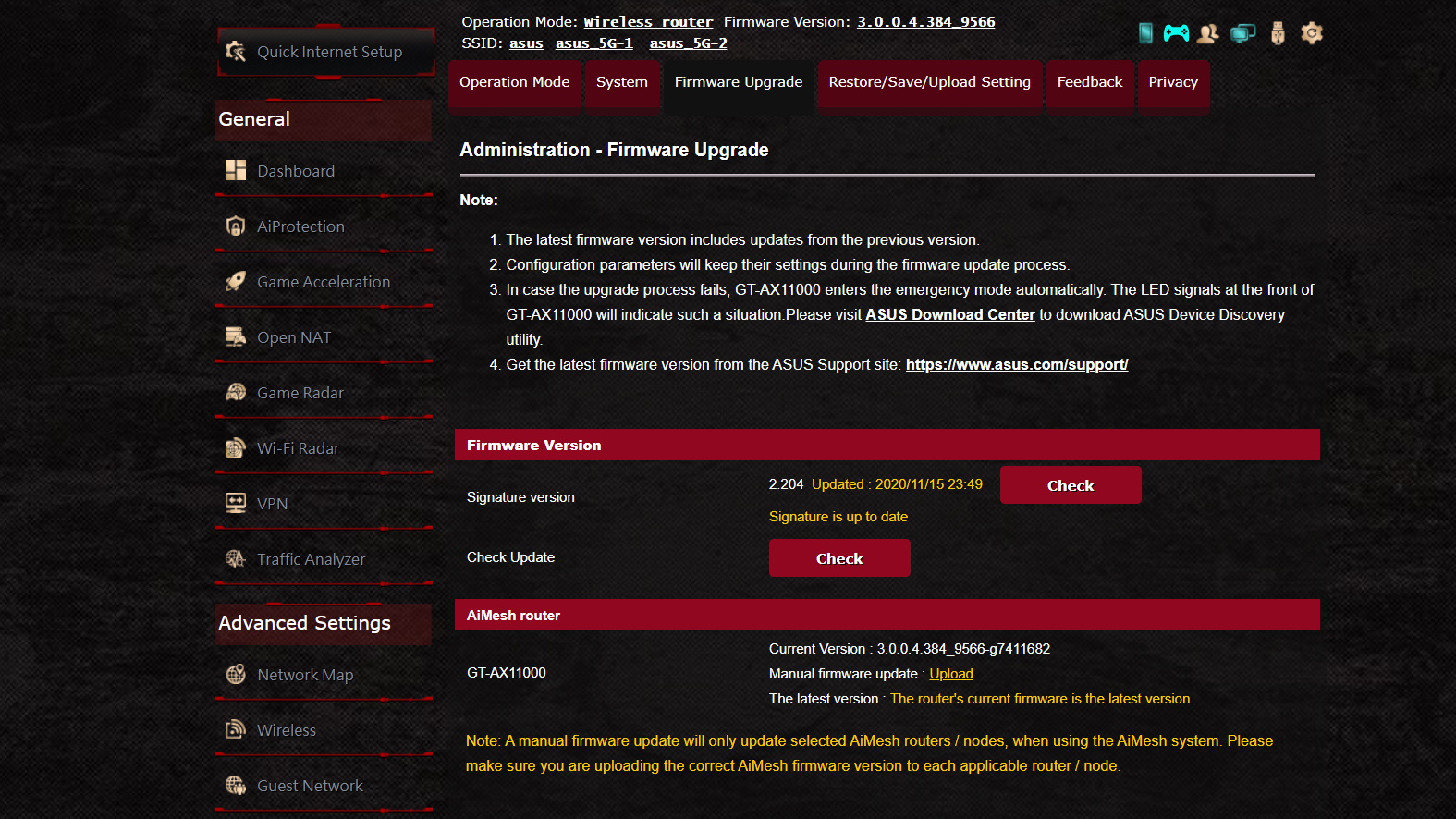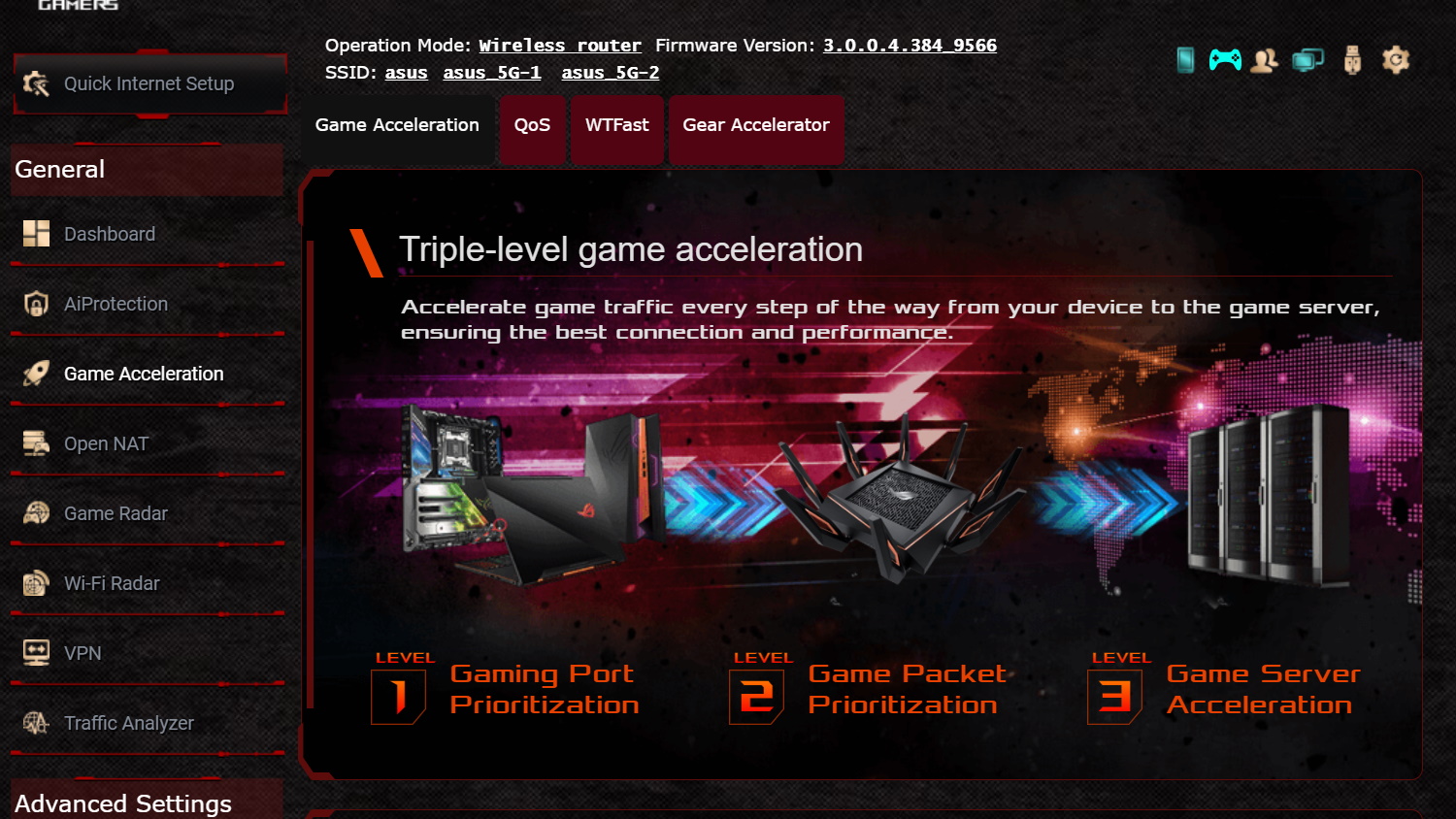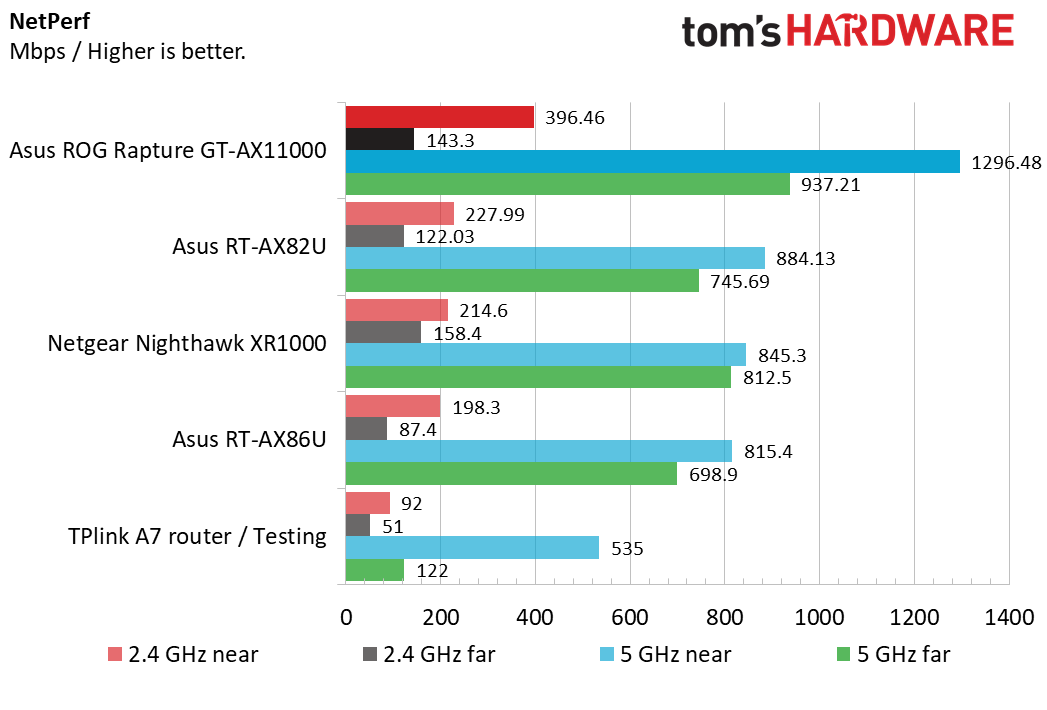Tom's Hardware Verdict
The high-end Asus ROG Rapture GT-AX11000 router brings oodles of highly configurable features to your network. But in our testing, the performance wasn't quite in line with the high price.
Pros
- +
Tri-band router
- +
Trend Micro security included
- +
High-end hardware specs
- +
WTFast
Cons
- -
Manual firmware upgrade bug
- -
Only five Ethernet ports
- -
Expensive
Why you can trust Tom's Hardware
For those who live their life by the “these go to eleven” philosophy, Asus has a high-end router for you. The Asus ROG Rapture GT-AX11000 ($450) includes nearly every feature you could reasonably ask for, then and adds in even more features for, as Nigel Tufnel would say "...that extra push over the cliff." If you're after a router that gives you lots of software tweaks and gaming-friendly options to prioritize your gaming traffic, it's a solid choice. But don't buy it for performance alone, because despite all those antennae, we've seen similar speeds on routers that cost much less—some of them from Asus' own product stack.
Design

If you're after an unobtrusive router that can sit inconspicuously on a shelf, this is the polar opposite. The Asus ROG Rapture GT-AX11000 is a horizontal router with no less than eight antennas deployed circumferentially around its chunky, square body, two to each side. Even its 3.8-pound weight will preclude it from some shelves, and it is quite visually loud. Adorned with orange accents, it would look more at home on the spaceship set of an Avengers sequel than in most living rooms, so plan your placement accordingly. To complete the look, the ROG logo in the center of the router is lit by Aura RGB, which thankfully can be turned off for those times when, for some reason, you don't want to draw attention to the large techno-crab-looking beast at the heart of your wireless world.
Specifications
| Processor | 1.8GHz quad-core processor | Row 0 - Cell 2 |
| Memory | 256MB NAND flash and 1GB DDR3 SDRAM | Row 1 - Cell 2 |
| Ports | RJ45 for Gigabits BaseT for WAN x 1, RJ45 for Gigabits BaseT for LAN x 4, Multi-Gig Ethernet port 2.5G/1G x1 USB 3.1 Gen 1 x 2 | Row 2 - Cell 2 |
| Encryption | Open system, WPA/WPA2-Personal, WPA/WPA2-Enterprise | Row 3 - Cell 2 |
| Wi-Fi Technology | IPv6 | Row 4 - Cell 2 |
| Row 5 - Cell 0 | Universal beamforming | Row 5 - Cell 2 |
| Row 6 - Cell 0 | 2.4GHz x3, 5GHz-1 x3, 5GHz2 x3 | Row 6 - Cell 2 |
| Dimensions | 11.3 x 4.74 x 14.86 inches | Row 7 - Cell 2 |
| Weight | 4.1 pounds | Row 8 - Cell 2 |
| Price | $449.99 | Row 9 - Cell 2 |
The specs for the ROG Rapture GT-AX11000 are undoubtedly impressive. At the heart is a quad-core 1.8 GHz CPU, with access to 256MB of NAND and 1GB of DDR3 SDRAM. The connections include a WAN port, along with four 1 GB Ethernet ports, and a 2.5 GB Ethernet port. If we want to nitpick, that does leave a total of five Ethernet ports, aside from the WAN, and we would have liked to have seen a few more. There are also a pair of USB 3.1 ports for adding networked storage. Physical buttons are as follows:
- WPS Button
- Reset Button
- Power Button
- Wireless on/off Button
- Boost Key
Wireless specs here also aim to impress, with the ability to send out three simultaneous signals, better known as tri-band, that supports the Wi-Fi 6 standard (also designated as 802.11ax). For the older 2.4 GHz frequency that is up to 1148Mbps, and for the 5 GHz, each frequency is up to 4804Mbps. Peak theoretical throughput is achieved via use of 160 MHz-wide data lanes, and OFDMA with Beamforming.
Setup

Setup of the GT-AX11000 starts with manually screwing in the eight antennas for the router. After attaching and plugging in the requisite wires, we next fired up our computer’s browser and followed the prompts for initial setup, including setting a wireless password.
A glitch we initially encountered was that the shipping firmware on the router out of the box was not able to be updated, even when we purposefully triggered an update. We just got a message that the router could not connect with the server. Thankfully, the workaround to manually search for and download the firmware code from the Asus website and then manually upload it to the router was successful. After that, the router could then connect to the Asus server automatically for further updates.
Features
The GT-AX11000 has bucketloads of features, and is sure to cover the needs of just about every reasonable use case for a gaming router. This includes integrated VPN, the ability to work with other Asus routers to create a mesh network, and a traffic analyzer.
Get Tom's Hardware's best news and in-depth reviews, straight to your inbox.
Focusing on the gaming features, the GT-AX11000 starts with tri-band frequencies, with the recommendation of Asus to designate one of the two 5 GHz bands only for gaming to avoid congestion altogether.
Then there is Triple Level Acceleration, with prioritization of the Gaming Port; Game First V which is client-side traffic shaping; Game Boost, Asus' name for gaming priority adaptive Quality of Service; and WTFast, a gamer’s private network. Yes, that’s four, and perhaps should be renamed Quadruple Level Acceleration.
Finally, there is Game Radar, which can measure ping times to various servers of different worldwide locations. In the above screenshot, we are looking at latency to several Overwatch servers to choose the best one to minimize lag.
Security
The GT-AX11000 has integrated security from Trend Micro, which supplies AiProtection Pro to the router for full network protection. Various functions are provided, which include a router security assessment to locate vulnerabilities and blocking of infected devices.
Performance
Using our Netperf software for throughput testing showed some solid results between this Asus GT-AX11000 router and our Wi-Fi 6 client. The near test gets run at 8 feet away with a direct line of sight, and far is 36 feet away on a different floor with ductwork intervening. This also demonstrates the significantly faster speeds on the 5 GHz frequency.
| Header Cell - Column 0 | 2.4 GHz near | 2.4 GHz far | 5 GHz near | 5 GHz far |
|---|---|---|---|---|
| Bandwidth (Mbps) | 396.46 | 143.3 | 1296.48 | 937.21 |
Using our Netperf software for throughput testing showed some solid results between this Asus GT-AX11000 router, and the Wi-Fi 6 client. The near test gets run at 8 feet away with a direct line of sight, and far is 36 feet away on a different floor with ductwork intervening. It also demonstrates the significantly faster speeds on the 5 GHz frequency.
| Testing Configuration | QoS | FRAPS avg | min | max | 8K dropped frames | Pingplotter spikes |
|---|---|---|---|---|---|---|
| Ethernet | No | 111.761 | 98 | 139 | n/a | 0 |
| Ethernet + 10 8k videos | No | 110.549 | 96 | 137 | 38.54% | 1 |
| Ethernet + 10 8k videos | adaptive, gaming priority | 106.933 | 94 | 137 | 35.80% | 1 |
| Ethernet, 2.5G port | No | 110.883 | 95 | 137 | n/a | 0 |
| Ethernet, 2.5G port, 10 8k videos | No | 24.283 | 9 | 41 | 62.20% | 10 |
| Ethernet, 2.5G port, 10 8k videos | adaptive, gaming priority | 101.717 | 56 | 133 | 13.40% | 6 |
| 5 GHz | No | 105.683 | 92 | 132 | n/a | 0 |
| 5 GHz + 10 8k videos | No | 109.067 | 92 | 134 | 57.90% | 0 |
| 5 GHz + 10 8k videos | adaptive, gaming priority | 111.467 | 97 | 138 | 3.30% | 1 |
| 2.4 GHz + 10 8k videos | adaptive, game priority | 109.7 | 94 | 127 | 27.80% | 4 |
Next, we look at the network congestion testing of the GT-AX11000. It’s not that the results were not plenty solid—they were—but rather that the bar was set so high in our minds for such a top-end gaming router.
For example, the 5 GHz gaming test with the ten 8k videos playing and QoS set to adaptive/game priority shows us how well that staggering amount of network congestion is handled. Our Overwatch game played at 111.467 FPS, a rate that closely matches the same game on a wired connection, yet the dropped frame rate on our 8k video was low at 3.3%, much lower than the 35.8% rate that was seen when the same test was run on Ethernet.
The tests run on the 2.5G Ethernet port show no improvement compared to the 1G Ethernet. Given that our test laptop (an Asus G512LW-WS74) doesn't have a 2.5GbE port, that's not exactly surprising. But oddly, the 2.5G test with the ten 8k video streams had the highest of the dropped frames on the video with QoS disabled at a sky-high 62.2%, worse than the 1G Ethernet port. The reasons for this aren't entirely clear, but could be some combination of hardware and software issues with the 2.5Gb port. Without a faster 2.5Gb device to test with, it's hard to say. But if your laptop or desktop doesn't have a 2.5Gb Ethernet port, the safe bet is to stick with one of the 1GbE port alternatives.
We also found that compared to the Asus RT-AX82U midrange router (which costs more than $200 less than its big brother) the scores are pretty similar, making it hard to justify the price difference, at least from performance alone.
Pricing
At a list price of $449, the Asus GT-AX11000 is clearly priced for the high-end market. The problem whenever you compare the top end of any product, such as a CPU, GPU or this router, is that you often bump up against the law of diminishing returns, with the price increasing substantially at the top end, while the features and performance are only a little better than the lower products beneath it. When analyzed from a pure value proposition, it is hard to argue in favor of the Asus GT-AX11000. But for those who want every possible bell and whistle in their wireless setup, then this Asus option makes a case for its crab-like self.
Bottom Line
Overall, while the Asus GT-AX11000 doesn't offer the best bang for the buck, it does still provide a solid piece of gear for those that can afford this higher price point. The pros include the integrated gaming features such as WTFast, adaptive QoS, and Game Radar. We also appreciate the included security to protect the network. Some shortcomings are the automatic firmware upgrade issue we encountered, the benchmark results in our testing that did not significantly best Asus’ own midrange alternative and only five Ethernet ports. But for those who like its looks, and who want their router to go to eleven, this Asus GT-AX11000 is a feature-packed, aggressive-looking option.
Just note the one cutting-edge feature this model lacks is 6E Wi-Fi, which makes use of the newly uncluttered 6GHz spectrum. For that, you'll need to pay $100 or so more, at least on the Asus side, and opt for the ROG Rapture GT-AXE1100. You may have to wait a bit to find that model in stock, however, as availability when we wrote this was pretty spotty, not unlike some of the best graphics cards or best CPUs.

Jonas P. DeMuro is a freelance reviewer covering wireless networking hardware.
-
Sergei Tachenov What, ONE 2.5 GbE port? So, if I send some data to that port at 2.5 Gbits/s, where is it supposed to go, since there are no other ports to match this speed?Reply -
shaolin95 This router is fantastic. I upgraded from a highly regarded xr500 and this asus is far superior. In a dead spot i used to get 30Mb down now o get almost 300Mb.Reply
My CSGO went from around 2:1 to 3:1 or even 4:1 ratios (heck even had a few 5:1 so far). Is like every shot I always felt was not registering before is doing so now.
I also love i can dedicate a band to my quest 2 for wireless gaming.
Big improvement! -
ittimjones ReplySergei Tachenov said:What, ONE 2.5 GbE port? So, if I send some data to that port at 2.5 Gbits/s, where is it supposed to go, since there are no other ports to match this speed?
The article doesn't seem to mention that it also supports WAN teaming. So as long as the teaming port isn't the same as the 2.5Gbps port, than you will get the teamed 2Gbps to the internet. -
Sergei Tachenov Ah, yes, it makes sense then. I see it also supports LAN teaming too, so I guess I can use a NAS that supports LAN aggregation and a PC with a 2.5 GbE NIC on the other end.Reply -
mrv_co Someone forgot to include "Ugly AF" under "Against". And what shelf exists that can't support 3.8 pounds? I'm just glad my UniFi WAPs have outstanding coverage and don't require the fugly antenna farm.Reply -
saunupe1911 Replyshaolin95 said:This router is fantastic. I upgraded from a highly regarded xr500 and this asus is far superior. In a dead spot i used to get 30Mb down now o get almost 300Mb.
My CSGO went from around 2:1 to 3:1 or even 4:1 ratios (heck even had a few 5:1 so far). Is like every shot I always felt was not registering before is doing so now.
I also love i can dedicate a band to my quest 2 for wireless gaming.
Big improvement!
Be sure to get a warranty. I'm a long time owner of a GT-AC5300. This is the ROG version with 8 ethernet ports which is what this thing should have as well. Welp the Wifi is extremely stable with pretty good range but the bottom row of ethernet ports will simply just stop working. I have to reboot a few times to get them to turn back on. It's so annoying and obliviously I'm out of warranty. At this point I realize why this model only has 4 smh. -
Sleepy_Hollowed This is a pretty insane router. The anti-malware is nice, though I don't know how good it would be in future more developed TLS 1.3 secured malware communication, but it will as hell catch most of the current ones.Reply
I hope it comes on as well by default and the protection is forever, this could be great for a house that splurges in one in terms of savings for protecting IoT devices.
I also can't believe that it looks like that, it's insane, almost like it's a prototype. -
yellowdog22 I've had the ax-11000 for a month or so now. Had an issue at the start with the NTP server settings but since i got it sorted all is good. For someone who uses VPN services such as NordVPN and ExpressVPN etc to circumvent geo location issues this router is really good.Reply
With vpn fusion you can add multiple vpn servers and then choose which devices use or don't use a particular VPN. Looks wise its a bit of a beast which I've got used to and now like.




